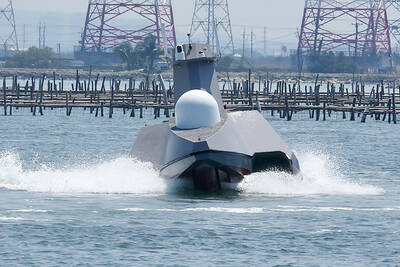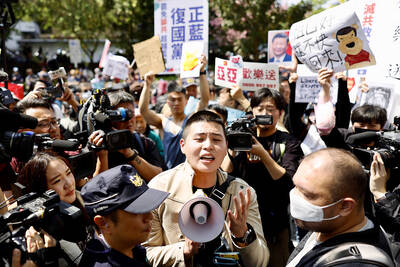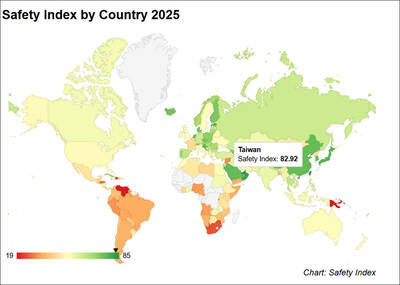Chinese Nationalist Party (KMT) Vice Chairman Hau Lung-bin (郝龍斌) yesterday urged KMT members to present a united front on the so-called “1992 consensus,” and cease the internecine conflicts that have driven a wedge between the camps of KMT Chairwoman Hung Hsiu-chu (洪秀柱) and former president Ma Ying-jeou (馬英九).
“In the past, the KMT’s cross-strait policy, which centers on adherence to the ‘1992 consensus’ and the ‘one China, with different interpretations’ framework, had only been challenged by the Democratic Progressive Party [DPP] and former president Lee Teng-hui (李登輝). Never before has it be a subject of contention within the KMT,” Hau said on Facebook.
With the approach of the Cross-Strait Peaceful Development Forum — which is scheduled to take place on Wednesday and Thursday next week in Beijing — it is critical that KMT members put forward a clear policy position and stop quarreling, the former Taipei mayor said.

Photo: George Tsorng, Taipei Times
The DPP’s difficulties over its stance on cross-strait relations demonstrate that the KMT’s cross-strait policy has been correct all along and that the “1992 consensus” and “one China, different interpretations” are vital to maintaining stable cross-strait development, Hau said.
“If even our own people reject that policy, we could lose the possibility of proving ourselves right through the failure of the DPP’s governance,” he said.
The “1992 consensus” refers to a tacit understanding between the KMT and Beijing that both sides of the Taiwan Strait acknowledge there is “one China,” with each side having its own interpretation of what “China” means. Former Mainland Affairs Council chairman Su Chi (蘇起) in 2006 said that he had made up the term in 2000.
At the center of the altercation between Hung’s and Ma’s camps is the policy platform passed by the party’s national congress early last month that aims to “further” the “1992 consensus” and explore the possibility of signing a cross-strait peace accord.
Critics have said the new platform is an attempt by Hung to move the KMT closer to the concept of “one China, same interpretation,” as it only mentions the “different interpretations” aspect of the “consensus” once in the introduction as part of the party’s history and omits the term in the latter part of the platform, which sets out the party’s main policy.
Hau said that without having a united front on the “1992 consensus” and “one China, different interpretations” the KMT would be in no position to question the DPP’s cross-strait policy or promote interactions across the Taiwan Strait.
“Also, how can we discuss a peace accord [with Beijing] if there is no consensus among Taiwanese and our position is not based on the foundation of ‘one China, different interpretations?’” Hau said.
Despite Hau’s calls for party solidarity, KMT Central Policy Committee director Alex Tsai (蔡正元) later yesterday took aim at Ma’s office, which issued a statement on Tuesday urging Tsai to study history more closely to gain a “more accurate understanding” of the content of the “1992 consensus.”
“Who is ‘Ma Ying-jeou’s office’ anyway? It published a weird news release without leaving the name of its spokesperson. It is no different from a fake Facebook account,” Tsai said on Facebook, urging the office to look at itself in the mirror before giving him directions.

ENDEAVOR MANTA: The ship is programmed to automatically return to its designated home port and would self-destruct if seized by another party The Endeavor Manta, Taiwan’s first military-specification uncrewed surface vehicle (USV) tailor-made to operate in the Taiwan Strait in a bid to bolster the nation’s asymmetric combat capabilities made its first appearance at Kaohsiung’s Singda Harbor yesterday. Taking inspiration from Ukraine’s navy, which is using USVs to force Russia’s Black Sea fleet to take shelter within its own ports, CSBC Taiwan (台灣國際造船) established a research and development unit on USVs last year, CSBC chairman Huang Cheng-hung (黃正弘) said. With the exception of the satellite guidance system and the outboard motors — which were purchased from foreign companies that were not affiliated with Chinese-funded

PERMIT REVOKED: The influencer at a news conference said the National Immigration Agency was infringing on human rights and persecuting Chinese spouses Chinese influencer “Yaya in Taiwan” (亞亞在台灣) yesterday evening voluntarily left Taiwan, despite saying yesterday morning that she had “no intention” of leaving after her residence permit was revoked over her comments on Taiwan being “unified” with China by military force. The Ministry of the Interior yesterday had said that it could forcibly deport the influencer at midnight, but was considering taking a more flexible approach and beginning procedures this morning. The influencer, whose given name is Liu Zhenya (劉振亞), departed on a 8:45pm flight from Taipei International Airport (Songshan airport) to Fuzhou, China. Liu held a news conference at the airport at 7pm,

Taiwan was ranked the fourth-safest country in the world with a score of 82.9, trailing only Andorra, the United Arab Emirates and Qatar in Numbeo’s Safety Index by Country report. Taiwan’s score improved by 0.1 points compared with last year’s mid-year report, which had Taiwan fourth with a score of 82.8. However, both scores were lower than in last year’s first review, when Taiwan scored 83.3, and are a long way from when Taiwan was named the second-safest country in the world in 2021, scoring 84.8. Taiwan ranked higher than Singapore in ninth with a score of 77.4 and Japan in 10th with

GRIDLOCK: The National Fire Agency’s Special Search and Rescue team is on standby to travel to the countries to help out with the rescue effort A powerful earthquake rocked Myanmar and neighboring Thailand yesterday, killing at least three people in Bangkok and burying dozens when a high-rise building under construction collapsed. Footage shared on social media from Myanmar’s second-largest city showed widespread destruction, raising fears that many were trapped under the rubble or killed. The magnitude 7.7 earthquake, with an epicenter near Mandalay in Myanmar, struck at midday and was followed by a strong magnitude 6.4 aftershock. The extent of death, injury and destruction — especially in Myanmar, which is embroiled in a civil war and where information is tightly controlled at the best of times —